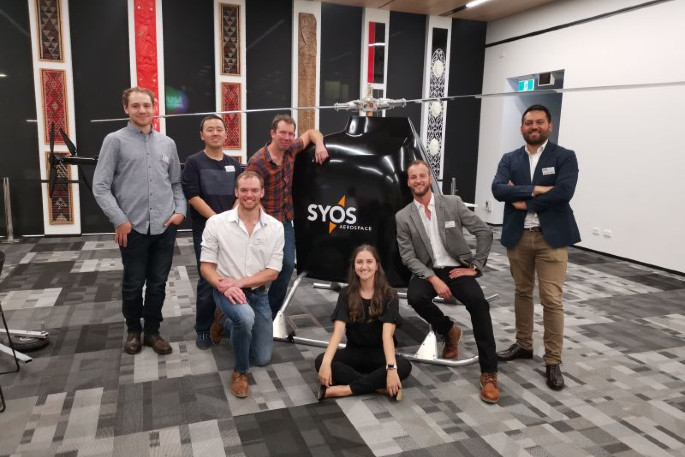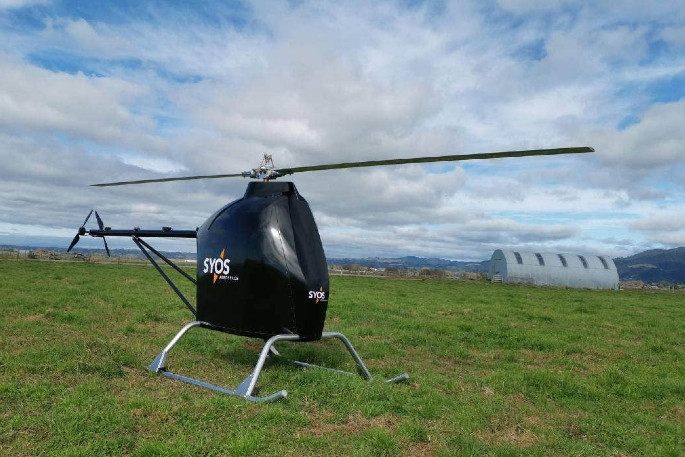A New Zealand-built pilotless helicopter, capable of lifting up to 200 kilograms, could help emergency responders deliver critical supplies into disaster zones, its creators say.
Syos Aerospace, started by Samuel Vye and Cameron Baker, has developed the SA200, a petrol or diesel powered unmanned aircraft which can carry payloads up to 200kg, has two hours flight time, a 100 kilometre flight range and 120kmh cruising speed.
Samuel says existing heavy lifting drones on the market were multi-copter drones with a diameter of about 9 metres and, because they were battery powered, had limited flight capability when carrying a heavy load.
'Realistically there is nothing out on the global marketplace that can compete with the performance characteristics of what we are seeing,” says Samuel.
The 160kg SA200, which at this stage was a prototype, has two rotors and a span of 1.5 metres, meaning it could fit on a trailer and be towed by a car, he says.
'It's a key point why we have opted for a helicopter design utilising a two rotor system.”
The next year would be spent testing to the SA200 to ensure it was 'reliable and robust” before going to market, he says.

The Syos Aerospace SA200 weighs 160 kilograms and can carry loads up to 200kg. Photo: Supplied.
Syos was planning to raise an undisclosed amount of capital at the end of this year, allowing it to set up a factory in the Bay of Plenty and employ a larger workforce to start manufacturing in the second half of next year.
It currently employs seven staff in Mount Maunganui.
Syos Aerospace was formed to commercialise research and development belonging to Samuel and Cameron's other company Envico Technologies, which develops technology for conservation projects in remote, difficult locations around the world.
They were finding that they could not find suitable drones on the market for their requirements, so they started building their own, Samuel says.
'We ended up eventually building bigger and bigger drones.
'We realise that these drones are actually really applicable to other areas.”
He expected about 90 per cent of sales would be international, to customers in cargo logistics, defence, agriculture and forestry.
He would not say how much the SA200 would cost but said it would be cheaper than any helicopter on the market.
At this stage a petrol combustion engine was being used because it provided a greater power to weight ratio compared to current and forecast battery technology, he says.
It could also incorporate a diesel engine, which was more suitable for defence force requirements.
Syos is also looking to incorporate developing autonomous flying into the SA200, allowing users to set flight parameters on a device enabling the drone to take off and fly a pre-programmed route.
The unit has been designed to fit onto a trailer and towed by a car, so it could be easily used in commercial operations such as orchard spraying, Samuel says.
'They can turn up with the drone on the back of a trailer, pull it off and within five minutes have completed their pre-start checks and the unit is taking off,” says Samuel.
'This becomes a lot more cost-efficient and easier to access sites than, say, manned helicopters having to fly to site from the local airport.”

The Syos team at their launch at Waikato University this week. Photo: Supplied.
Cameron says a key application for the drone would be for use in disaster relief logistics.
Its size and strength would allow it to transport supplies into the field, he says.
'We can easily and safely get from A to B to aerially deploy critical supplies.”
Cameron says said it was looking to gain Civil Aviation Authority (CAA) certification for its drone.
All unmanned aircraft certification under a CAA rule allows the operation and testing of larger drones and unmanned aircraft, as well as smaller drones being used for more complicated operations.
The CAA recently met the team behind Syos as part of discussions about the certification options available to Syos in New Zealand, he says.
The CAA was working closely with Envico Technologies for its development and testing of unmanned aircraft for predator control, he says.
Envico Technologies is one of the first of a growing list of partners in an Airspace Integration Trials Programme, dedicated to supporting the development, testing and market validation of advanced unmanned aircraft and adjacent technologies, he says.



1 comment
great team of kiwis.
Posted on 23-05-2021 10:06 | By grayman
what a great team of innovative kiwis.can only hope that they have huge success with this project and can keep it in new zealand Good luck
Leave a Comment
You must be logged in to make a comment.